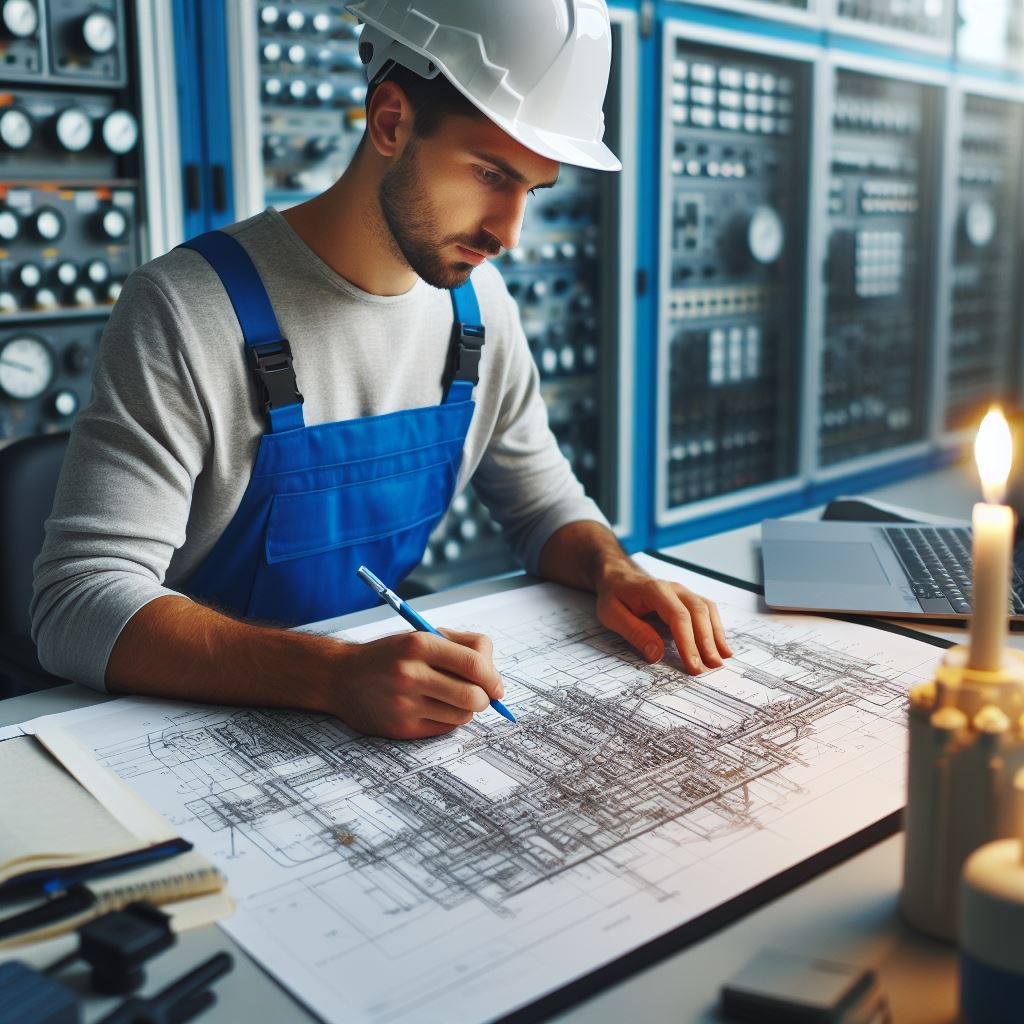Introduction
A day in the life of an Aussie technical drafter involves important roles in various industries. This blog aims to provide insights into their daily routine.
Technical drafters are crucial in creating precise and detailed drawings for engineering and architectural projects.
They play a significant role in translating ideas into practical designs, ensuring accuracy and functionality.
Technical drafters are essential in the manufacturing, construction, and engineering sectors. They work closely with engineers and architects to produce accurate blueprints, schematics, and diagrams.
These professionals possess a deep understanding of drafting software and are skilled in creating detailed plans that adhere to industry standards and regulations.
The purpose of this blog post is to shed light on the routine of an Aussie technical drafter.
By understanding their daily tasks and responsibilities, readers can gain a better appreciation for the precision and expertise required in their profession.
From collaborating with design teams to incorporating changes, technical drafters are constantly engaged in creating and updating drawings to support the design and construction process.
In the upcoming sections, we will explore how an Aussie technical drafter spends their day, from attending meetings and reviewing project requirements to using drafting software and communicating with colleagues.
By gaining a deeper understanding of their role, readers can appreciate the impact these professionals have on shaping the built environment.
Stay tuned for an insightful journey into the day in the life of an Aussie technical drafter.
Overview of the Role
A. What a technical drafter is and their responsibilities
A technical drafter plays a crucial role in various industries by creating detailed drawings and plans for construction projects and manufacturing processes.
They are responsible for transforming complex ideas and designs into understandable and precise visual representations.
Technical drafters work closely with engineers and architects to develop accurate blueprints and schematics.
They use computer-aided design (CAD) software to produce 2D and 3D models, incorporating measurements, dimensions, and other specifications.
Not only do technical drafters create initial drafts, but they also revise and modify existing drawings based on feedback and project requirements.
They ensure that all designs adhere to industry standards, guidelines, and safety regulations.
Furthermore, technical drafters collaborate with multiple teams, such as project managers, fabricators, and construction workers, to ensure seamless communication and efficient project execution.
B. Industries Commonly Employing Technical Drafters
1. Construction Industry
- Technical drafters play a vital role in construction projects by creating architectural drawings, structural plans, and electrical layouts.
- They assist in the development of buildings, bridges, roads, and other infrastructure projects.
2. Engineering Industry
- In the engineering field, technical drafters are essential for designing and drafting mechanical, electrical, and civil engineering projects.
- They create detailed diagrams and plans for machinery, equipment, and systems.
3. Manufacturing Industry
- Technical drafters contribute to the manufacturing sector by producing plans and specifications for the production of various products.
- They work with manufacturers to design efficient production processes and assembly lines.
4. Aerospace and Defense Industry
- Technical drafters are involved in designing and drafting aerospace components, aircraft structures, and defense equipment.
- They ensure compliance with strict industry standards and regulations.
5. Automotive Industry
- Technical drafters help in the development of automotive prototypes, parts, and systems.
- They assist in creating designs for car frames, engines, and electrical systems.
6. Electronics Industry
- In the electronics sector, technical drafters are responsible for creating circuit board designs and wiring diagrams.
- They contribute to the development of various electronic devices and systems.
7. Renewable Energy Industry
- Technical drafters play a role in designing and drafting plans for renewable energy projects, such as solar and wind farms.
- They assist in creating efficient and sustainable energy solutions.
8. Telecommunications Industry
- Technical drafters contribute to the telecommunications industry by designing communication networks and infrastructure.
- They create diagrams for cables, routers, and other communication systems.
Overall, technical drafters are essential in a wide range of industries, ensuring accurate and efficient implementation of complex projects and designs.
Starting the Day
- The typical start time for an Aussie technical drafter is around 8:00 am.
- Before beginning work, they usually go through their morning routines and preparations.
- This can include having breakfast, showering, getting dressed, and commuting to the office.
- Some drafter may prefer to exercise or meditate in the morning to prepare for the day ahead.
- Once they arrive at the office, they greet their colleagues and settle into their workspace.
- Before diving into their drafting tasks, they may spend a few minutes organizing their tools and materials.
- This can involve checking their computer, software programs, and any relevant documents or drawings.
- They might also make a to-do list or prioritize their tasks for the day to stay organized.
- After everything is set up, they are ready to start working on technical drawings and designs.
- Using drafting software and tools, they begin creating or modifying drawings based on project requirements.
Tasks and Responsibilities
Throughout the day, technical drafters perform a variety of primary tasks to ensure accurate and precise designs.
These tasks include:
A. Creating detailed drawings
Technical drafters use CAD software to create precise drawings of products, buildings, or machinery.
These drawings serve as a visual representation of the final design.
B. Reviewing and modifying designs
After creating initial drawings, drafters carefully review them for accuracy and completeness.
They make necessary modifications based on client requirements, engineering specifications, or industry standards.
Your Personalized Career Strategy
Unlock your potential with tailored career consulting. Get clear, actionable steps designed for your success. Start now!
Get StartedC. Collaborating with engineers
Technical drafters work closely with engineers to understand project requirements and translate them into technical drawings.
They seek feedback and clarification to ensure the design aligns with the engineering specifications.
D. Incorporating changes
As the design progresses, drafters incorporate any changes or revisions suggested by engineers or clients.
They update drawings and ensure all modifications are accurately implemented.
E. Ensuring compliance with standards
Technical drafters adhere to industry standards and regulations while creating designs.
They ensure that their drawings meet specific codes, standards, and guidelines relevant to the project.
The use of computer-aided design (CAD) software is essential for technical drafters, as it enables them to work efficiently and produce accurate drawings.
F. CAD software offers various benefits, including:
- Improved efficiency: CAD software allows drafters to create and revise drawings much faster than using traditional methods. It provides tools and features that streamline the drafting process, saving time and effort.
- Precise measurements and calculations: CAD software offers precise measurements and calculations, ensuring accurate dimensions and specifications. This feature helps drafters avoid errors and miscalculations in their drawings.
- Easy modification and replication: With CAD software, drafters can easily modify or replicate designs. They can make changes to specific elements or create multiple versions of a design without starting from scratch.
Attention to detail and precision play a crucial role in the work of technical drafters.
These qualities are vital for producing accurate and error-free drawings.
Here’s why attention to detail is important:
- Ensures accuracy: Technical drafters must pay close attention to every detail to ensure accuracy in their drawings. Even the smallest error can lead to design flaws or operational issues down the line.
- Guarantees safety and functionality: A high level of precision is required to ensure that the drawings align with safety codes and regulations. The accuracy of the design directly impacts its functionality and reliability.
- Enhances communication: Attention to detail allows drafters to clearly communicate the specifications and requirements of the design.
Other professionals, such as engineers or manufacturers, can easily understand and interpret the drawings.
In general, technical drafters perform various tasks throughout the day, including creating detailed drawings, collaborating with engineers, and ensuring compliance with standards.
CAD software, combined with attention to detail and precision, enables drafters to produce accurate and reliable designs.
Read: Challenges Faced by Modern Architects
Collaboration and Communication
A. Interactions technical drafters have with engineers, architects, and other professionals
Collaboration and communication are vital for technical drafters, as they interact with engineers, architects, and other professionals on a daily basis.
Effective communication within the team is crucial for ensuring successful project outcomes.
- Technical drafters work closely with engineers, providing detailed drawings and plans based on their specifications.
- They collaborate with architects, translating their designs into technical drawings that can be used for construction or manufacturing purposes.
- Collaboration with other professionals, such as interior designers or project managers, helps in delivering accurate and precise drawings for various project requirements.
- Clear and concise communication is important when discussing project details, timelines, and any modifications required.
- Technical drafters actively participate in meetings, sharing their expertise and seeking clarifications to ensure accurate representation of the project.
- They provide regular updates to the team, ensuring everyone is aware of the progress and any issues that may arise.
B. The importance of effective communication within the team
Effective communication fosters teamwork, allowing technical drafters to work seamlessly with engineers, architects, and other professionals.
Stand Out with a Resume That Gets Results
Your career is worth more than a generic template. Let us craft a resume and cover letter that showcase your unique strengths and help you secure that dream job.
Get Hired- By understanding the intentions and expectations of the team, technical drafters can deliver drawings that meet the desired outcomes.
- Collaborative brainstorming sessions help in finding innovative solutions and identifying any potential design flaws or errors.
- Technical drafters play an important role in bridging the gap between the design and production processes.
- They communicate technical requirements and standards to the manufacturing or construction teams, ensuring that the final product meets the required specifications.
- Constant communication with engineers and architects enables technical drafters to address any design challenges or modifications promptly.
- Effective communication also helps in identifying potential cost-saving measures and improving efficiency in the drafting process.
- Regular communication and collaboration with other professionals provide technical drafters with valuable insights and learning opportunities.
- By actively participating in discussions, technical drafters can enhance their knowledge and skills in various aspects of their work.
C. Enhancing Technical Drafting Success Through Collaboration and Communication
- Sharing information and expertise with colleagues creates a positive work environment, fostering creativity and continuous improvement.
- Effective communication within the team also helps in avoiding misunderstandings and reducing the likelihood of errors in the final product.
- Technical drafters rely on clear communication channels to seek feedback and ensure that their drawings meet the expectations of the team.
- Collaboration and communication with other professionals facilitate a cohesive approach towards project completion.
- Ultimately, effective collaboration and communication contribute to the overall success of technical drafting projects, resulting in high-quality and accurate drawings.
In review, technical drafters interact with engineers, architects, and other professionals on a regular basis, highlighting the importance of effective communication.
Collaboration and communication enable them to deliver accurate drawings, address design challenges, and ensure project success.
Problem-Solving and Troubleshooting
Problem-solving is an essential skill for technical drafters, who often face challenges in their daily work.
A. The challenges technical drafters may face and how they solve them
They encounter design issues that require their problem-solving skills to find effective solutions.
One of the main challenges is dealing with complex design problems that arise during the drafting process.
Technical drafters have to analyze the situation and come up with innovative solutions to overcome these challenges.
They must possess strong critical thinking skills and the ability to think outside the box to find the best solution.
Another challenge technical drafters face is troubleshooting errors that may occur in their designs.
They have to thoroughly review their drawings and identify any mistakes or inconsistencies that need to be resolved.
Technical drafters often work closely with engineers and designers to understand their requirements and resolve any conflicts.
Collaboration is crucial to solving design issues as teamwork allows for different perspectives and ideas.
In some cases, technical drafters have to modify existing designs to meet new requirements or overcome limitations.
They must carefully consider the impact of these changes and ensure they do not affect the overall functionality of the design.
B. Their problem-solving skills and ability to find solutions for complex design issues
Technical drafters use various tools and software to assist in their problem-solving process.
Computer-aided design (CAD) software allows them to create, modify, and analyze designs quickly and accurately.
These software tools provide different functionalities that aid in finding solutions to complex design issues.
Technical drafters also rely on their knowledge of industry standards and regulations to solve problems.
They must ensure that their designs comply with relevant safety and quality standards.
In addition to technical knowledge, effective communication skills are essential for technical drafters.
They often need to communicate with other team members, such as engineers or architects, to understand design requirements.
Clear communication helps to resolve any conflicts and find the best solution for the design issues at hand.
Furthermore, technical drafters need to be adaptable and flexible in their problem-solving approach.
They must be open to feedback and willing to make changes to their designs if necessary.
Adapting to new technologies and staying updated with industry trends also helps them find better solutions.
In short, technical drafters face various challenges in their work, but their problem-solving skills enable them to find solutions.
They tackle complex design issues, troubleshoot errors, and collaborate with others to overcome challenges.
Their ability to think critically, use software tools effectively, and communicate clearly is key to their success.
Technical drafters are problem solvers, finding solutions that contribute to the overall success of a project.
Read: Historic Preservation in Australian Architecture

Quality Control and Review
Quality control is a vital aspect of technical drafting, ensuring accuracy and adherence to specifications at all stages.
It involves systematic examination and measurement of products to ensure they meet the desired standards.
Quality control ensures that technical drawings are precise, error-free, and ready for production or construction.
A. The significance of quality control in technical drafting
- One of the primary goals of quality control in technical drafting is to prevent errors and reduce the need for rework.
- By catching and rectifying errors early on, quality control saves time, resources, and minimizes potential risks.
- Quality control is crucial in technical drafting as errors can result in costly revisions, rework, and even project delays.
- It helps guarantee that the final output meets the needs of clients, stakeholders, and regulatory requirements.
- The review process is an integral part of quality control, providing an opportunity for critical evaluation and feedback.
- During the review process, technical drafters collaborate with team members, supervisors, and clients to ensure accuracy.
- Reviews involve systematic examination of technical drawings and related documents to identify errors and inconsistencies.
- They help ensure that the drawings are complete, conform to standards, and accurately represent design intent.
- The review process includes comprehensive checks for dimensions, tolerances, annotations, and any missing or inaccurate information.
- Peer reviews involve having another drafter or team member review the drawings for errors, clarity, and adherence to standards.
- The reviewer looks for any potential issues, such as incorrect dimensions, misplaced symbols, or missing details.
B. The review process and steps taken to ensure accuracy and adherence to specifications
- Reviewers may also assess the overall organization, layout, and visual presentation of the technical drawings.
- Feedback from reviewers is used to enhance the quality, accuracy, and clarity of the technical drawings.
- Steps are taken to address any comments, suggestions, or corrections provided during the review process.
- Drafters carefully consider the feedback received and make necessary revisions to improve the quality of the drawings.
- To ensure accuracy, drafters also utilize software tools that automatically check for errors and adherence to standards.
- These tools flag potential issues related to dimensions, annotations, layering, or other technical aspects.
- Validation procedures, such as test fits or simulations, may also be employed to verify the accuracy of the technical drawings.
- Regular training and professional development help technical drafters stay updated on industry standards and best practices.
- Quality control is an ongoing process, with continuous improvement as its aim, to enhance the overall quality of technical drafting.
- Therefore, quality control is paramount in technical drafting to ensure accuracy, adherence to specifications, and successful project outcomes.
- The review process, along with systematic checks, peer reviews, and feedback, plays a significant role in achieving these goals.
You Might Also Like: Drafting Internships: Stepping Stone in Aus
Professional Development and Continuous Learning
A. The importance of staying updated with industry advancements
Professional development and continuous learning are vital for an Aussie Technical Drafter to stay relevant and competitive in the industry.
Staying updated with industry advancements is crucial.
- It helps to acquire new skills and knowledge that can be applied to enhance job performance.
- It enables professionals to adapt to evolving technologies and methodologies, ensuring they can meet the changing demands of their job.
- It enhances career prospects and increases the likelihood of career progression within the drafting field.
- It fosters personal growth and self-improvement, allowing individuals to reach their full potential.
- It demonstrates a commitment to excellence and professionalism, which can lead to increased trust and respect from colleagues and clients.
B. Opportunities for professional development and further education in the field of technical drafting are abundant.
- Industry conferences and seminars provide the chance to learn from experts and network with peers.
- Online courses and webinars offer flexible learning options, allowing professionals to continue their education while working.
- Professional associations and trade organizations often provide educational resources, workshops, and certifications.
- Collaborative projects and teamwork provide opportunities to learn from colleagues with different perspectives.
- Mentoring programs can offer guidance and support from experienced professionals in the field.
C. Participating in professional development activities can have numerous benefits for an Aussie Technical Drafter.
- It increases job satisfaction by providing new challenges and opportunities for growth.
- It expands professional networks, opening doors to new career opportunities and potential collaborations.
- It helps professionals stay updated with the latest industry trends, technologies, and best practices.
- It improves problem-solving and critical thinking skills, enabling individuals to tackle complex drafting projects more effectively.
- It enhances communication and teamwork abilities, facilitating effective collaboration with colleagues and clients.
To make the most of professional development opportunities, it is essential for Aussie Technical Drafters to have a proactive approach.
Transform Your LinkedIn for Maximum Impact
Elevate your professional brand with a LinkedIn profile that attracts recruiters, showcases your expertise, and maximizes opportunities. Stand out in your industry with a profile built for success.
Boost Profile- They should regularly research and stay informed about industry advancements and upcoming events.
- They should identify their specific areas for improvement and seek out relevant training and educational resources.
- They should develop a professional development plan and set goals to stay motivated and focused.
- They should actively participate in professional communities, such as online forums or social media groups, to exchange knowledge and experiences.
- They should regularly assess and reflect on their progress and make adjustments to their professional development strategies as needed.
Most importantly, staying updated with industry advancements through continuous learning and professional development is integral for an Aussie Technical Drafter.
By seizing opportunities for further education and growth, professionals can enhance their skills, stay competitive, and thrive in the dynamic field of technical drafting.
Read: Surveying 101: An Aussie’s Intro to the Field
Gain More Insights: Civil Engineering Ethics: An Aussie Perspective
Work-Life Balance and Job Satisfaction
Work-life balance and job satisfaction are two important factors to consider in any profession, including technical drafting.
Technical drafters are professionals who play a crucial role in the design and development of various projects.
They translate complex engineering drawings into detailed plans and specifications that are used for construction and manufacturing purposes.
A. Potential Flexibility in Working Hours for Technical Drafters
- Technical drafters often enjoy some degree of flexibility in their working hours.
- They may have the option to work part-time or on a flexible schedule.
- This flexibility allows them to balance their personal and professional commitments.
- In some cases, technical drafters can even work remotely, avoiding long commutes and saving time.
- This flexibility is particularly beneficial for those with family or other personal obligations.
B. Satisfaction from Seeing a Project Come to Life
- One of the most rewarding aspects of being a technical drafter is seeing a project come to life.
- After spending hours creating detailed drawings, seeing those plans materialize is incredibly fulfilling.
- Technical drafters take pride in knowing that their work contributes to the success of a project.
- They play a vital role in turning ideas and concepts into tangible structures.
- This satisfaction motivates technical drafters to continue delivering high-quality work.
C. Potential Challenges in Maintaining a Work-Life Balance
- While technical drafters have some flexibility, maintaining work-life balance can still be challenging.
- Workload fluctuations and tight deadlines can sometimes disrupt the balance.
- Technical drafters may need to work extra hours or weekends to meet project deadlines.
- This can lead to increased stress and reduced personal time.
- Additionally, technical drafters need to continuously update their skills to stay relevant in the industry.
Overall, work-life balance and job satisfaction are crucial aspects to consider in the career of a technical drafter.
While technical drafters enjoy some flexibility in their working hours, they may face challenges in balancing their personal and professional commitments.
Nevertheless, the satisfaction that comes from seeing a project come to life makes the profession fulfilling and rewarding.
Read: Project Management Tips for Architects
Conclusion
Being a technical drafter is a rewarding profession with valuable contributions in various industries.
Technical drafters play a crucial role in designing and creating accurate technical drawings and plans.
They are responsible for ensuring that construction projects are executed smoothly and efficiently.
Technical drafters possess excellent skills in using computer-aided design (CAD) software and translating complex engineering concepts into detailed drawings.
They collaborate closely with architects, engineers, and other professionals to bring projects to life.
With their attention to detail, problem-solving abilities, and knowledge of industry standards and codes, technical drafters help minimize errors and ensure the quality of designs.
Their work provides the foundation for successful construction projects, infrastructure development, and manufacturing processes.
Furthermore, technical drafters constantly update their skills to keep up with advancements in design technology.
They stay informed about the latest software updates and industry trends to deliver innovative and efficient solutions.
Overall, a day in the life of an Aussie technical drafter involves precision, creativity, and collaboration.
The profession offers a fulfilling and rewarding career path with opportunities for growth and professional development.
So, if you have a passion for design, attention to detail, and a love for turning ideas into reality, become a technical drafter and make your mark in various industries.




